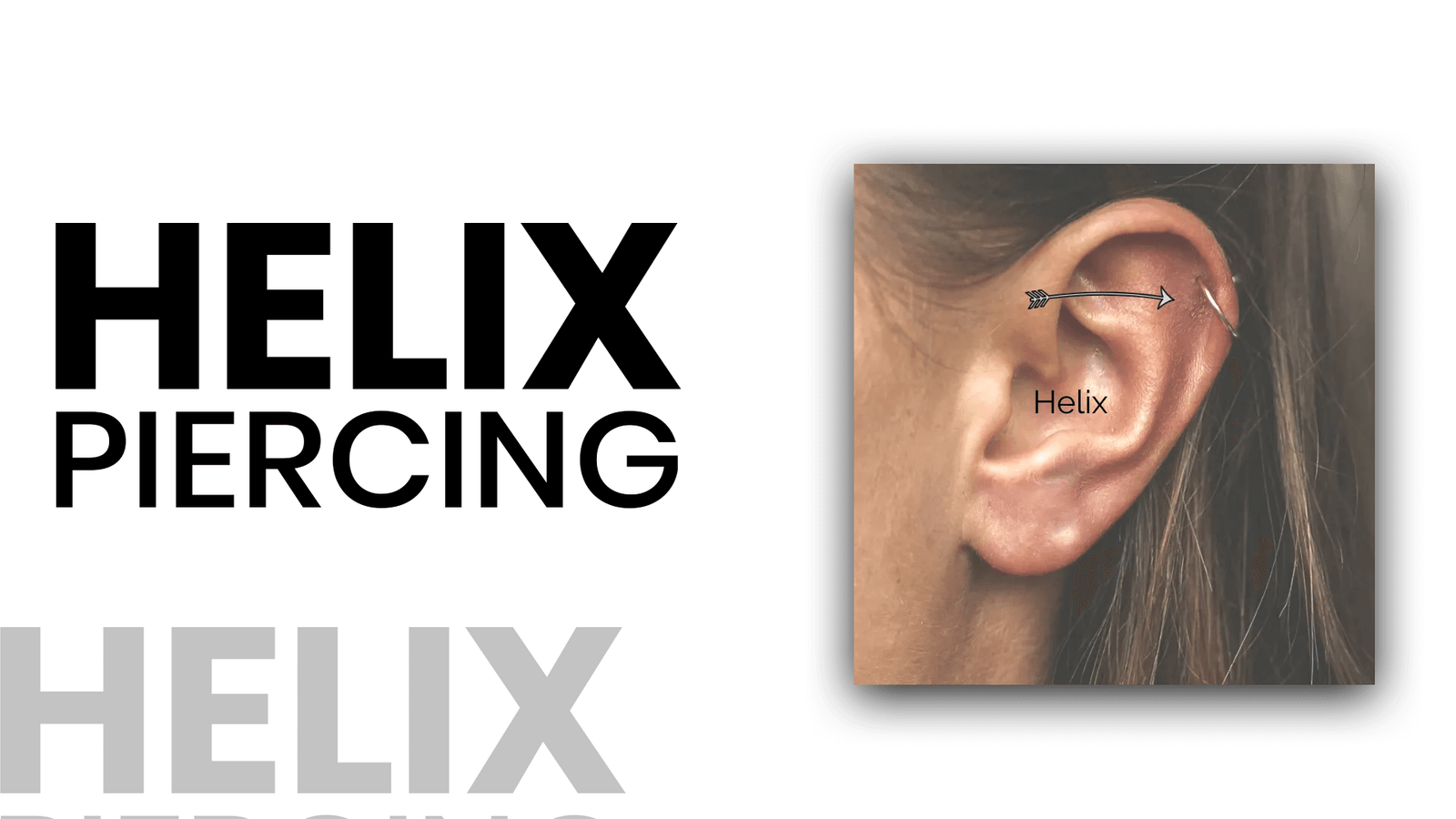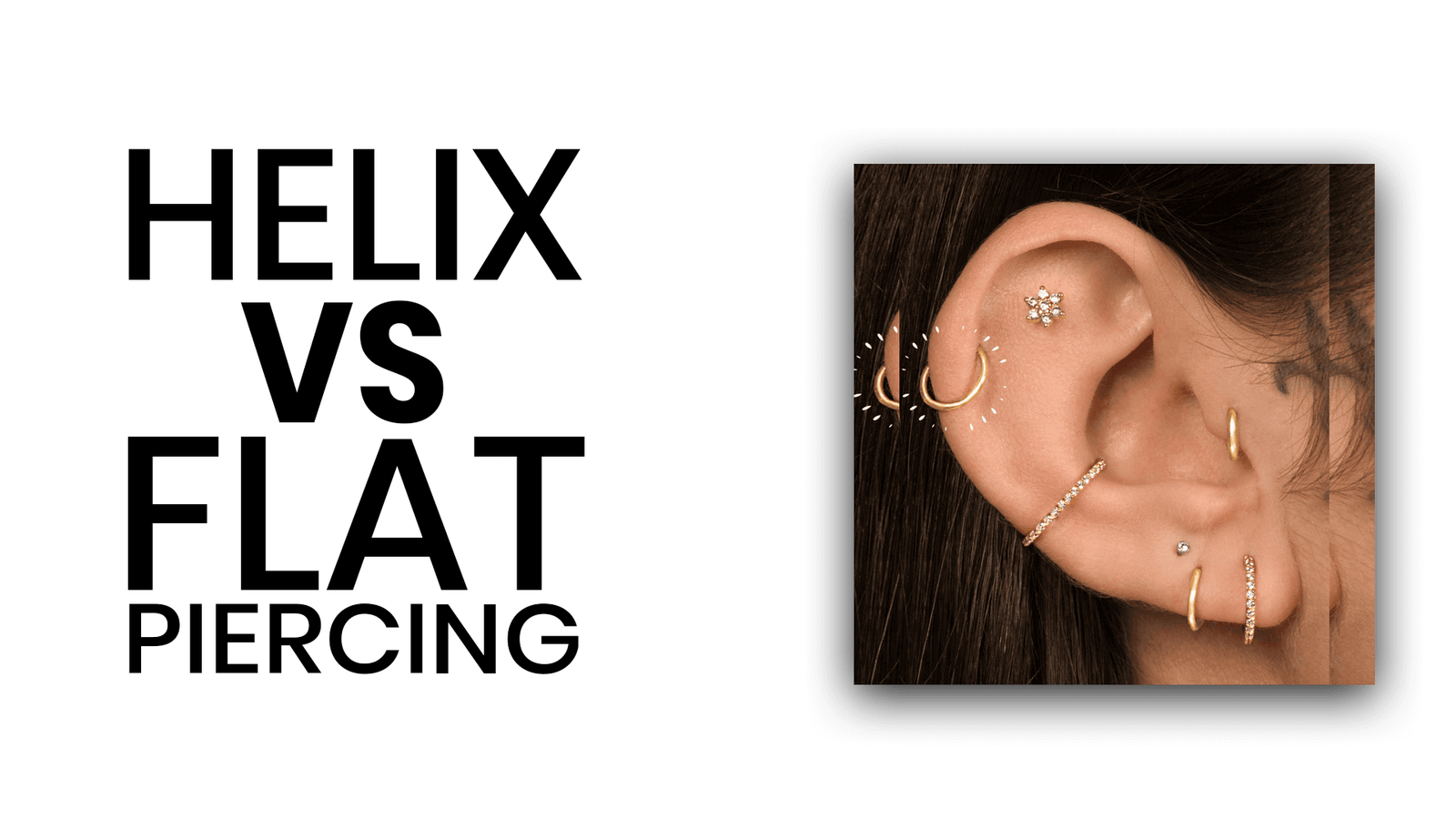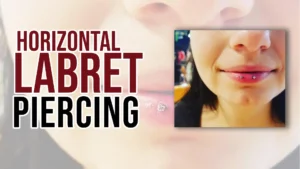Overview
Body modification has long been a part of human civilization, and now, piercing is one of the most well-liked types of modification. There are many types of piercings, but helix vs. flat piercing is one of the most contentious. The flat piercing is on the flat part of the ear, whereas the helix piercing is on the top ear cartilage. Both kinds of piercings have grown in popularity recently as more people choose to show their individuality and personal style through them. The degree of pain, length of healing, and post-piercing care are among the distinctions between the two types of piercings. The pros and cons of the helix and flat piercings will also be covered in this post so that you can decide which one is right for you.
Helix Piercing

A common type of ear piercing called a helix involves piercing the cartilage of the upper ear, usually just outside the ear’s rim. This piercing, which can be done on one or both ears, is a popular choice for those who seek a more distinctive or edgy appearance. Some common types of helix piercings are forward helix, double helix, triple helix, industrial, and orbital piercings.
Procedure
To do a helix piercing, a hollow needle is commonly used. The piercer removes the needle after passing through the cartilage and fits the jewelry into the hole. Some piercers might also employ a piercing gun; however, this technique is typically not advised because it might increase the risk of problems and inflict additional ear stress.
Aftercare
It’s crucial to properly care for the area following the piercing to prevent infection and accelerate healing. To avoid placing pressure on the piercing, this usually entails cleaning the region with a saline solution or mild soap, abstaining from touching it with unclean hands, and avoiding sleeping on the side with the piercing for a few weeks.
Side Effects
The formation of a keloid, a large, elevated scar that develops around the piercing site, is one potential side effect of helix piercing. This may occur more frequently in those prone to keloids or where the piercing was performed improperly. Treatment options for keloid development could involve corticosteroid injections, surgical excision, or other procedures.
Pain Level
The outer curve of the ear has few nerve endings; the helix is one of the least painful cartilage piercings. The helix piercing is at a four on a scale of pain levels.
Healing time
The helix piercing, on the other hand, will heal completely in three to six months. Overall, getting your helix pierced can be a safe and effective method to express your style, but to reduce the potential of issues, selecting a reputable piercer and caring for the piercing afterward is critical. The helix piercings heal quickly when you follow aftercare procedures consistently and appropriately. Avoid using the bathtub and the pool since they can harbor bacteria. Before touching the piercing, wash your hands with soap.
Jewellery for Helix Piercings
Studs
Studs are a traditional and straightforward alternative for helix piercings. They may be a wise choice if you want a casual, low-maintenance appearance.
Hoops
There are many different sizes and kinds of hoops, which are a common choice for helix piercings. They are an excellent option for a special occasion and can give your outfit a little edge.
Ear cuffs
For helix piercings, ear cuffs are a stylish and distinctive solution. They are a fantastic option if you want to try out various designs without committing to a permanent piercing because they sit on the ear and don’t require a piercing.
Cost
A helix piercing typically costs between $20 and $80. However, costs may be higher in some places or for jewelry or piercing options that are more intricate.
Pros of Helix Piercing
- With a helix piercing, you can wear both studs and hoops.
- It is thought to reduce stress and insomnia.
- It could lessen allergic symptoms.
- Its price is quite reasonable.
Cons of Helix Piercing
- As it cuts through cartilage, it hurts quite a bit.
- Due to the poor blood supply to cartilage, healing takes a very long time.
Flat Piercing

Instead of standard body piercing sites like the earlobe, nostril, or navel, flat piercings involve piercing the skin’s flat surface. Surface piercing is another name for this kind of body modification, typically done on the wrist, collarbone, or nape of the neck. A flat piercing needle is used to make the piercing, which creates a hole in the skin’s flat surface through which the jewelry will pass. Some common types of flat piercings are basic flat, Vertical flat, double, multiple, and dermal anchor piercings. You must consult a reputable and experienced piercer for any flat piercing according to your preference and body type.
Procedure
Like other body piercings, a flat piercing requires special training and experience. The piercer must first evaluate the area to be pierced to choose the ideal location for the piercing, and the piercer will mark the entry and exit points of the piercing with a sterile marker after adequately cleaning the skin with an antiseptic solution. The piercer will then make the hole using a unique flat piercing needle.
The piercer will insert jewelry into the hole once the piercing is complete. A flat, disk-shaped piece of metal or another material is usually the jewelry used for a flat piercing. The jewelry should be of a biocompatible substance, such as surgical-grade stainless steel, titanium, or gold, to reduce the chance of an allergic reaction or infection.
Aftercare
Flat piercing care is crucial to avoid infection, rejection, or migration. The piercing site should be washed frequently with saline or an antiseptic solution to maintain it bacteria-free. The jewelry should be carefully turned while cleaning to prevent it from sticking to the skin. Additionally, it’s crucial to keep clean hands away from the piercing and to protect them from harsh chemicals and too much moisture.
Side Effects
Due to its positioning on the flat surface of the skin, flat piercings carry a higher risk of complications than conventional body piercings. Selecting a skilled piercer with experience in surface piercings and according to their instructions is crucial if you’re thinking about getting a flat piercing and follow their aftercare instructions.
Pain level
Both piercings hurt because they go through cartilage. The flat piercing hurts more than the helix because there are fewer nerve endings along the outer ridge of the ear where the helix sits; a flat piercing hurts more than a helix. The flat piercing is between a six and a seven on a scale of 1 to 10 pain level.
Healing Time
The flat piercing will take six months to a year to fully heal with the proper aftercare procedures. It’s best to get a flat piercing done on one side first because you can’t sleep on one until it has fully healed.
Jewellery for Flat Piercings
Surface Bars
Curved bars that rest flat against the skin’s surface are known as “surface bars.” They are made specifically for surface piercings and assist in lowering the possibility of migration or rejection.
Flat Discs
Flat discs are jewelry items with a disc shape that rest flat against the skin. Due to their understated and elegant appearance, they are preferred for flat piercings.
Captive Bead Rings
Captive bead rings have a removable bead in the center and are spherical. They can be an excellent solution for flat piercings if they are neither tight nor loose.
Cost
A flat piercing often costs between $40 and $100. However, prices might be higher in some locations or for more elaborate jewelry or piercing options.
Pros of Flat Piercing
- It has an appeal all by itself.
- It goes well with both the forward helix and the ear piercings.
- It costs from $40 to $100 and is reasonable.
- Cons of Flat Piercing
- Since it pierces through cartilage, it hurts more.
- It takes between six and twelve months for it to heal.
- In order to avoid bumps and infections necessitates more aftercare.
- You cannot sleep on it until the piercing is fully healed.
Conclusion
After learning about the differences and similarities between the helix and flat piercings, you can select the piercing that best suits you and schedule an appointment with a qualified piercer. In conclusion, helix and flat piercings are common body art providing unique and fashionable expression methods. Both piercings are relatively easy to perform but require specialized knowledge and experience to reduce the risk of complications. Ultimately, since each piercing has distinct advantages and disadvantages, deciding between a helix and flat piercing comes down to personal preference. It’s crucial to pick a reputed piercing studio and follow the correct aftercare guidelines to ensure a safe and effective piercing experience. Whatever piercing you select, keep in mind that safety and quality should take precedence over appearance or cost to ensure a satisfying and long-lasting result. Remember that both piercings require healing time, and you should stick to the aftercare instructions to avoid problems.





